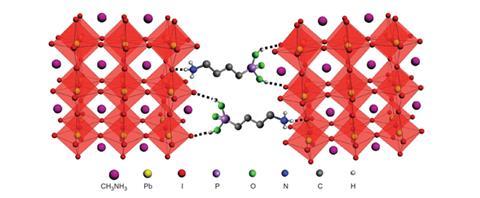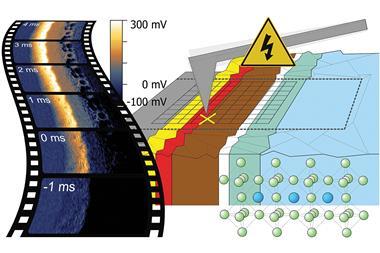New solar cell is stable, moisture resistant and has an efficiency of 16%
A new perovskite solar cell with 16% efficiency has been developed by researchers from Switzerland and China. The cell is also stable and moisture resistant, overcoming some of the problems that have traditionally affected perovskites.
In recent years, several researchers have spotted the potential of hybrid organic-inorganic halide perovskites for photovoltaic (PV) applications. They could be a lot less expensive than crystalline silicon PVs, but achieving high performance and long-term stability is difficult.
‘Achieving the moisture stability is a big Achilles’ heel problem to bring future advances in perovskite solar cells to commercial fruition,’ says Tobias Hanrath of Cornell University in the US, who was not involved in the research. ‘These results are an important step in that direction.’

The resulting solar cell has greatly enhanced stability, the researchers say, because of stabilising crosslinks in the material. These are formed by the phosphonic acid ammonium additive hooking together the perovskite crystallites through strong hydrogen bonding with the phosphorus- and nitrogen-containing terminal groups of the linker molecule. The team explains that the additive allows the perovskite to be incorporated uniformly within and on the surface of a mesoporous titanium dioxide scaffold material. This not only nearly doubles the efficiency from 8.8 to 16.7% but makes it moisture resistant, as the cations passivate the surface and render it inaccessible to water molecules.

‘Our work on directing perovskite crystal engineering will continue,’ Grätzel tells Chemistry World. ‘First, [we will] eliminate completely the hysteresis in the J-V curves by improving the selective contacts for charge carrier extraction. This should also enhance the fill factor and hence the overall efficiency of the device. Secondly, [we will] move to mixed methyl ammonium/formamidinium cation formulations for the perovskites which perform better than formulations based on methylammonium alone.’
‘It is great to see a new one-step solution-processing technology to make perovskite solar cells with higher stability and efficiency – two critical factors for this type of material,’ says Fengqi You, a photovoltaics researcher at Northwestern University in the US. ‘The results are exciting and shed light on the future development in this area,’ he adds. ‘Further studies would be needed to consider the life cycle energy consumption and environmental impacts of this technology for industrial-scale manufacturing of perovskite solar cells.’












No comments yet